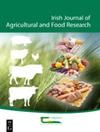Animal performance and economic implications of alternative production systems for dairy bulls slaughtered at 15 months of age
IF 1.4
4区 农林科学
Q3 AGRICULTURE, MULTIDISCIPLINARY
引用次数: 5
Abstract
Abstract The objectives of this experiment were to investigate (i) the influence of varying levels of concentrate supplementation during the grazing season, (ii) alternative finishing strategies for dairy bulls slaughtered at 15 mo of age and (iii) economic implications of these management strategies. Bulls were assigned to a 2 (level of concentrate supplementation during the grazing season: 1 kg [LA] and 2 kg [HA] dry matter [DM]/head daily) × 2 (finishing strategies: concentrates ad libitum group [AL] or grass silage ad libitum plus 5 kg DM of concentrates/head daily group [SC]) factorial arrangement of treatments. Average daily gain (ADG) during the grazing season was greater (P < 0.01) for HA than for LA. Consequently, HA bulls were 16 kg heavier at housing: 214 and 230 kg, respectively (P < 0.05). During the finishing period, ADG tended (P = 0.09) to be greater for LA than for HA. Carcass weight tended (P = 0.08) to be greater for HA than for LA. Fat score was greater for HA. Live weight at slaughter (P < 0.001) and carcass weight (P < 0.001) were 41 and 23 kg greater for AL than for SC, respectively. Conformation (P < 0.05) and fat score (P < 0.05) were greater for AL than for SC. The Grange Dairy Beef Systems Model simulated whole-farm system effects of the production systems. Net margin/head was greater for LA than for HA and greater for SC than for AL. Sensitivity analysis of finishing concentrate price, calf purchase price and beef price showed no re-ranking of the systems on a net margin basis. Although greater animal performance was observed from the higher plane of nutrition, overall profitability was lower.15月龄屠宰的奶牛替代生产系统的动物性能和经济影响
本试验的目的是研究(i)放牧季节不同精料添加水平的影响,(ii) 15月龄屠宰的奶牛的替代肥育策略,以及(iii)这些管理策略的经济意义。饲喂2(精料补充水平:1 kg [LA]和2 kg [HA]干物质[DM]/头/日)× 2(肥育策略:精料自由使用组[AL]或草青贮自由使用+精料5 kg DM /头/日组[SC])析因处理。放牧季平均日增重(ADG) HA组显著高于LA组(P < 0.01)。因此,HA公牛在围场时体重增加了16 kg,分别为214和230 kg (P < 0.05)。在肥育期,LA组的平均日增重高于HA组(P = 0.09)。HA组胴体重倾向于大于LA组(P = 0.08)。HA患者的脂肪评分更高。AL组的屠宰活重(P < 0.001)和胴体重(P < 0.001)分别比SC组高41和23 kg。AL的构象(P < 0.05)和脂肪评分(P < 0.05)高于SC。田庄牛乳系统模型模拟了生产系统的整个农场系统效应。LA的净利润率高于HA, SC的净利润率高于AL。精料价格、小牛收购价和牛肉价格的敏感性分析显示,在净利润率的基础上,这两个系统没有重新排序。虽然从较高的营养水平观察到较高的动物生产性能,但总体盈利能力较低。
本文章由计算机程序翻译,如有差异,请以英文原文为准。
求助全文
约1分钟内获得全文
求助全文
来源期刊
CiteScore
2.50
自引率
20.00%
发文量
23
审稿时长
>36 weeks
期刊介绍:
The Irish Journal of Agricultural and Food Research is a peer reviewed open access scientific journal published by Teagasc (Agriculture and Food Development Authority, Ireland). Manuscripts on any aspect of research of direct relevance to Irish agriculture and food production, including plant and animal sciences, food science, agri environmental science, soils, engineering, buildings, economics and sociology, will be considered for publication. The work must demonstrate novelty and relevance to the field of research. Papers published or offered for publication elsewhere will not be considered, but the publication of an abstract does not preclude the publication of the full paper in this journal.

 求助内容:
求助内容: 应助结果提醒方式:
应助结果提醒方式:


